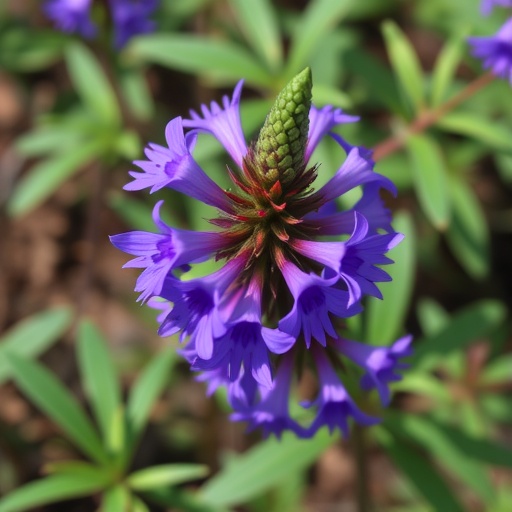Exploring the Potential of Indigofera tinctoria: The Blue Gold of India’s Sustainable Future
Indigofera tinctoria, commonly known as indigo, has been revered for centuries due to its vibrant natural dye, which has profoundly influenced culture and art globally. However, recent research underscores its potential not just as a source of dye but as a linchpin in sustainable agriculture and ecological restoration. The study conducted by Rao et al. highlights the multifaceted benefits of cultivating this leguminous plant, which can play a critical role in India’s sustainable future.
Historically, Indigofera tinctoria has been synonymous with the color blue due to the indigo dye derived from its leaves. This plant has captured the attention of artisans, designers, and biologists alike, earning its place in the annals of textile history. Today, as the fashion and dye industries shift towards more sustainable practices, the full spectrum of indigo’s potential is coming to light, suggesting a pathway to a more eco-friendly future. The research signifies a compelling argument for reintegrating this ancient crop into contemporary agricultural practices.
One of the most promising aspects of Indigofera tinctoria is its nitrogen-fixing ability. This characteristic allows the plant to enrich the soil by converting atmospheric nitrogen into a form that plants can absorb and use. By practicing crop rotation with indigo, farmers can improve soil fertility without the reliance on synthetic fertilizers, which often lead to soil degradation and water pollution. Thus, the cultivation of indigo not only supports sustainable farming practices but also enhances the ecosystem’s health.
Additionally, the economic benefits of Indigofera tinctoria cultivation cannot be overlooked. As farmers transition from synthetic dyes to natural alternatives, the demand for indigo is expected to increase significantly. This shift is not merely a trend but rather a necessity as consumers become more environmentally conscious. With adequate support and investment, farmers can tap into new markets, fostering economic stability while also contributing to sustainable practices. This dual benefit provides a compelling argument for adopting Indigofera tinctoria as a mainstream agricultural product.
The research by Rao and colleagues also delves into the ecological implications of cultivating Indigofera tinctoria. Its growth promotes biodiversity and provides habitats for various organisms, contributing to the resilience of local ecosystems. Additionally, the deep root system of indigo helps prevent soil erosion, which is increasingly important in the face of climate change and extreme weather events. By enhancing soil structure and moisture retention, Indigofera tinctoria can mitigate some of the adverse effects associated with climate-related challenges.
As the textile industry grapples with its environmental footprint, natural dyes like those derived from Indigofera tinctoria offer a satisfactory solution. The research indicates that the environmental cost of synthetic dye production is staggering, with pollution and waste posing significant health risks to both humans and the ecosystem. By promoting the use of natural indigo, industries can significantly reduce their ecological impact, making a strong case for its reintegration into modern manufacturing.
Moreover, cultivation of Indigofera tinctoria can also contribute to social sustainability. The revival of traditional dyeing practices not only preserves cultural heritage but also empowers local artisans and communities. Training programs that teach indigo dyeing techniques can provide valuable skills, fostering a sense of pride and ownership in local crafts and arts. This, in turn, creates economic opportunities while also safeguarding cultural identity.
The study also cautions about the potential challenges associated with scaling up indigo production. While the benefits are clear, there are hurdles in terms of agricultural practices, market access, and climate conditions. A key component of promoting Indigofera tinctoria will involve extensive research into optimal growing conditions, pest management, and post-harvest processing. This knowledge will be essential for helping farmers transition to this sustainable crop.
As we consider the future of agriculture in the wake of climate change, Indigofera tinctoria serves as a beacon of hope. Its ability to work harmoniously with nature rather than against it positions it as an essential element in the quest for sustainable agricultural practices. The cultivation of indigo embodies the principles of permaculture, emphasizing the interconnectedness of all elements within an ecosystem.
Future research must focus on optimizing growing practices, improving pest management strategies, and developing markets for indigo products. This will ensure not only the viability of Indigofera tinctoria as a sustainable crop but also its popularity among consumers who are increasingly looking for eco-friendly alternatives in their purchasing decisions.
The time for Indigofera tinctoria to regain its status as a valuable agricultural product is now. As studies like that of Rao et al. illustrate, the potential for this “blue gold” to transform India’s agricultural landscape is immense. Not only can it boost local economies and support smallholder farmers, but it can also lead to significant ecological benefits, creating a win-win scenario for agriculture and the environment.
In essence, Indigofera tinctoria represents a fusion of tradition and modernity, a symbol of what sustainable agriculture can achieve when it draws on the strengths of cultural practices. As we stand on the precipice of ecological crises, the wisdom of ancient agricultural practices combined with innovative scientific research may indeed provide a pathway toward a more sustainable future.
Subject of Research: The ecological and economic benefits of cultivating Indigofera tinctoria.
Article Title: Indigofera tinctoria: the blue gold of India’s sustainable future.
Article References: Rao, P.S., Fatima, N., Siddiqui, M.H. et al. Indigofera tinctoria: the blue gold of India’s sustainable future. Discov Sustain 6, 1135 (2025). https://doi.org/10.1007/s43621-025-01120-0
Image Credits: AI Generated
DOI:
Keywords: Indigofera tinctoria, sustainable agriculture, eco-friendly dyes, biodiversity, soil health, nitrogen fixation, economic opportunities, cultural heritage.




